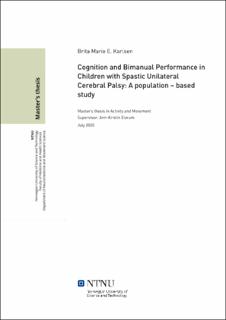| dc.description.abstract | Background: Children with unilateral cerebral palsy (CP) may experience difficulties in performing daily activities, due to reduced bimanual performance and cognitive impairments. Both reduced bimanual performance and cognitive impairments may interact and hamper the acquisition of functional skills in daily life. Therefore, it is important to gain further insight into the interplay between cognition and bimanual performance in children with unilateral CP. Aim: Primary aim: examine the association and relationship between hand function and cognition in a population-based sample of children with spastic unilateral CP. Secondary aim: to explore the strength of the associations between bimanual performance and cognitive functions. Method: A cross-sectional study design was used, and registered data from Cerebral Palsy Register of Norway (CPRN), formal follow-up protocol for cognition (CPCog) and Cerebral Palsy Follow-up Program (CPOP) was used in this study. Pearson r was used to examine correlation between the variable, and a linear multiple linear regression analysis was used to analyse the relationship between the variables.
Results: 83 children were included in the final sample mean. There was a moderate correlation between full-scale IQ and bimanual performance, but full-scale IQ did not significantly contribute to the variance in bimanual performance (AHA). However, strong correlations were found between bimanual performance, manual ability (MACS) and active use of the affected hand (House). Both manual ability and active use of the affected hand significantly contribute to 65% of the variance in bimanual performance. There were weak correlations between FRI, PSI, WMI and VSI (Wechsler tests) and bimanual performance (AHA), but the indexes did not significantly contribute to the variance in bimanual performance.
Discussion: Manual ability and active use of the affected hand have an effect on bimanual performance, nevertheless, IQ does not. It is possible that other cognitive components, such as executive function, can have an effect on bimanual performance. Therefore, future research should consider examining the relationship between executive function and bimanual performance in children with unilateral CP. | |
